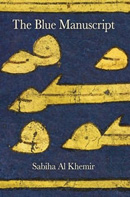

Verso, paperback, 9781844674176
The Blue Manuscript by Sabiha Al Khemir is a tale woven of stories and miracles, of the sublimity of art and the crassness of art dealers, of human ambition and longing for connection. The novel, almost as intriguing for its apparent faults as for its definite virtues, is about an archeological dig in Wadi Hassoun, outside of Cairo during the 1980s. The purpose of the dig is to find the second volume of the priceless Blue Manuscipt, a Quran commissioned during the tenth-century Fatimid dynasty in Egypt by the mother of Caliph al-Muizz.
The archeological team, led by Mark, is beholden to European investors who hope to make a fortune from the find. His Egyptian contact, Mustapha, is the son of a museum guard, a devout Muslim and ambitious entrepreneur. The international team includes the British Professor O'Brien, more interested in the lusterware of the Fatimids than the manuscript; Alan, his student; Donatella, the beautiful Italian archeologist; Hans, nicknamed "Glasses," the German conservator; Kodama San, the Japanese site surveyor; Monia, the Egyptian archeology inspector; Rayyes Ahmed, the local contractor; and Zohra, the Tunisian-English translator, who is torn between her Arabic and Western heritages.
The beauty of the book lies in its lyrical descriptions of both the natural and the spiritual landscapes of the desert environs and the inhabitants of Wadi Hassoun. The novel opens, closes and is punctuated by the meditations and tales of Amm Gaber, the ancient, blind storyteller who speaks to the Tree of Wishes. Om Omran, the keeper of the saint's shrine, serves daily tea to the archeological team and issues warnings about the jealous dead spirits in the cemetery and local jinns. The Muslim and Coptic Christian inhabitants of Wadi Hassoun, while on the brink of modern technology, still live in a world infused with an immanent sense of the sacred and the power of nature as manifested in a deadly dust storm. The timelessness of Wadi Hassoun is emphasized by episodes in the novel that flash back to creation of the Blue Manuscript in the Tenth Century.
Where the novel seems to falter is in the somewhat flat and shallow characterizations of the archeological team members. The omniscient narrator floats in and out of each of the characters perceptions, especially their observations and judgments of the other characters. Sometimes this technique results in awkward descriptions and dialogue. Yet—it could be argued that the shallowness of the descriptions is actually how the characters know and perceive each other. Despite a welcome general tolerance among the team members, there is little bridging of cultural or personal gaps. Finally each character is left in his or her own, quite existential, reality. In this novel, individual characters are far less important than elements of timeless value: nature, tales handed down through generations, and works of art lovingly crafted.
Sabiha Al Khemir, a Tunisian-born Islamic art historian and artist as well as an author, draws the reader into the world
of Islamic art with her thoughtful and detailed descriptions of the calligrapher's mission: "Ibn al-Warraq reflected on
the silent power of beauty. A sacred immensity opened with the limited space of the page, written in gold on blue vellum,
in elongated, unvocalized Kufic script…. The line of letters went on in its continuous search. Letters transmitted by
the sweeps of the pen…. In the infinite depth of the night blue, the manuscript a crescendo of silence. The dark blue,
a sea of depth, a night that called for immersion, a space of contemplation". The novel may be somewhat challenging
to a Western reader's expectations, but I found it fascinating and well worth the journey.
Interview: "Sabiha al Khemir on Islam and the West," Smithsonian Magazine, August 2010
